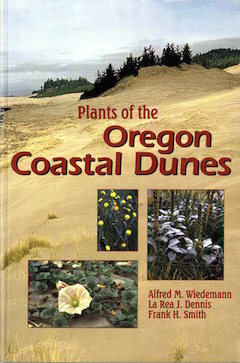Plants of the Oregon Coastal Dunes
Last Updated on November 21, 2022 by

by Alfred M. Wiedemann, La Rea J. Dennis, Frank H. Smith
ISBN 0-87071-457-0
Oregon State University Press, Corvallis, Oregon, 1999 (revised edition)
This slim paperback has served as the standard reference for coastal plants for more than forty years. It offers simple keys for identification, supplemented by black and white photos of many species. After a general introduction to dune ecology, sand dynamics and plant succession, the authors describe almost 100 species of plants common to the Oregon coast. Species are grouped by family, starting with ferns and proceeding through composites. There is a list of references in the introductory section and a glossary in the back.
Unfortunately, the taxonomy and nomenclature are outdated. Although comfortable to those of us who learned botanical names a few decades ago, this adds another step to the identification process. However, this book can get the reader to a useful name that serves as a synonym to search for the current scientific name in the new Flora or on the internet. A more important weakness is the ongoing influx of new species to the coastal dunes, an entire array of introduced species not included in the book. While this book’s strength continues to be helping novices identify native plants, it also serves as a troubling reminder of how rapidly our coastal plant communities are changing.
The formation of dune fields and moving sand fields is one of the most fascinating sections, but would benefit from an update with modern knowledge of how subduction zone earthquakes and subsequent tsunamis affect dune formation. For example, in the Clatsop Plains of the north coast of Oregon, each dune ridge formed directly following a local subduction zone earthquake, not through a long process of building and deflation of sand moving across the landscape.
I remember when I bought a copy of the original edition in the 1970s. The glued spine promptly broke and I had it rebound with a plastic toothed spine. It still sits on my reference shelf today. Despite its age, this book is a good starter field guide to native plants of coastal dunes.
—Kathleen Sayce, Filipendula Chapter.
